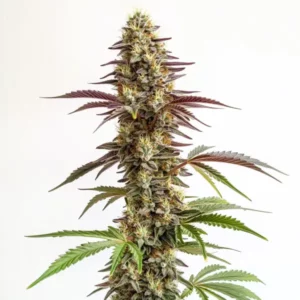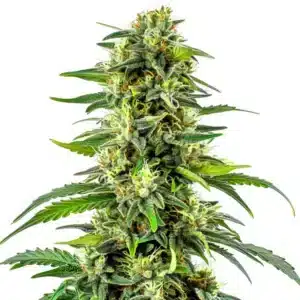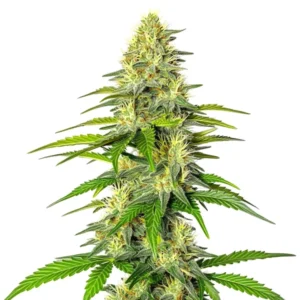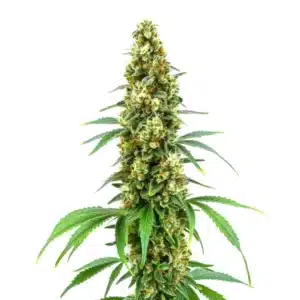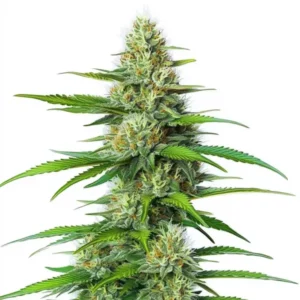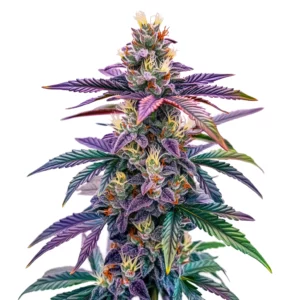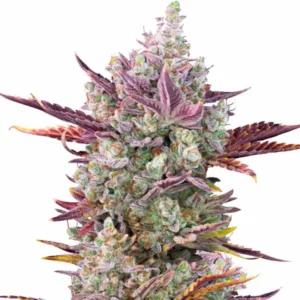
Best Coco Coir Nutrients
Growing cannabis in coco coir can be an incredibly rewarding endeavor. However, it does come with its unique set of challenges. Understanding which nutrients to use is key to helping your plants thrive and yield a bountiful harvest. Coco coir is an organic growing medium derived from coconut husks. Its ability to retain moisture while providing excellent aeration makes it highly beneficial for cannabis cultivation.
Moreover, the sustainability aspect of coco coir appeals to many gardeners. By choosing this natural substrate, you’re making a choice that aligns with eco-friendly gardening practices. Whether you’re a novice or a seasoned grower, knowing how to optimize your use of coco coir can lead to a successful growing experience.
Recommended Strains
Blue Cookies
|
|
THC | 18% - 21% (Medium) |
|
|
Type | Feminized |
|
|
Yield | Medium |
|
|
Phenotype | 90% Indica / 10% Sativa |
Blue Dream
|
|
THC | 17% - 24% (Medium) |
|
|
Type | Feminized |
|
|
Yield | High |
|
|
Phenotype | 50% Indica / 50% Sativa |
Why Use Coco Coir?
Coco coir offers several advantages over traditional soil as a growth medium. One significant benefit is its remarkable capacity to retain moisture while allowing excess water to drain away efficiently. This feature is especially crucial as it helps prevent root rot, a common pitfall in cannabis cultivation. Furthermore, coco coir boasts a neutral pH, making nutrient management simpler and more effective.
Many growers are drawn to coco coir because it promotes healthy root development. Consistent airflow around the roots is vital. With coco coir, it becomes easier to achieve ideal aeration, leading to stronger, more vigorous plants. Additionally, sustainability is increasingly important in modern gardening, and coco coir is a renewable resource, which supports environmental stewardship.
Promos & Deals
The Importance of Nutrients
Even with the right growth medium, cannabis plants need a comprehensive nutrient plan to thrive. Nutrients serve as the building blocks for plants, participating in numerous biological processes essential for growth and development. From enhancing vegetation to supporting flowering, the right nutrient balance is key when using coco coir, as it does not contain inherent nutrients.
In general, cannabis plants require three primary macronutrients: nitrogen, phosphorus, and potassium. Each of these plays a pivotal role in plant health. Nitrogen (N) is essential for vegetative growth, encouraging lush foliage; phosphorus (P) supports robust root systems and flower development; while potassium (K) enhances overall health and helps plants resist diseases. Understanding these needs is crucial for successful cultivation in coco coir.
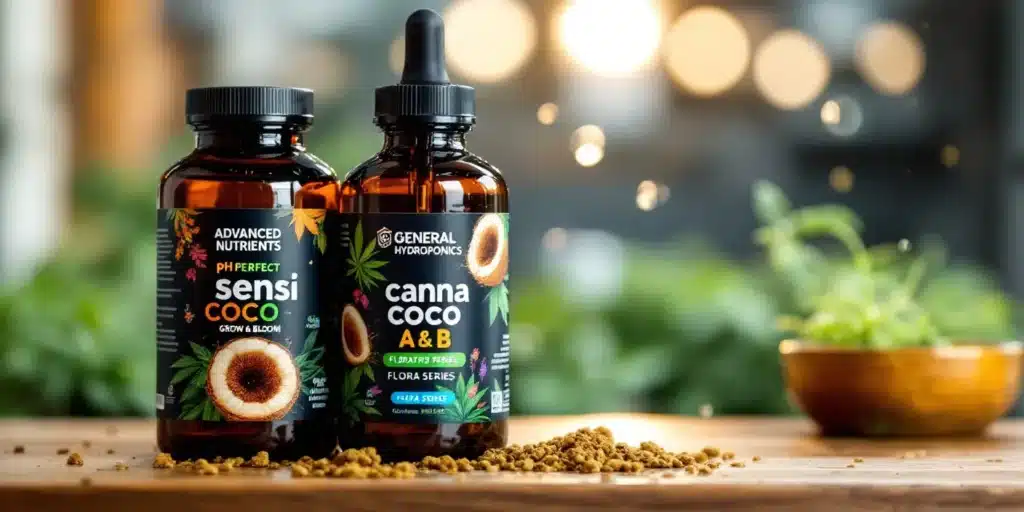
Best Coco Coir Nutrients for Cannabis
Selecting the right nutrients for your cannabis grown in coco coir can significantly influence growth quality and yield. A variety of brands specialize in products explicitly designed for this medium. Here are some of the most reputable nutrients recommended for growing cannabis in coco coir:
- Advanced Nutrients pH Perfect Sensi Grow & Bloom: This innovative two-part nutrient system is tailored specifically for users of coco coir, automatically adjusting pH levels for optimal nutrient absorption.
- Canna Coco A & B: This well-balanced duo provides a comprehensive nutrient solution suitable for all stages of plant growth. Renowned for its reliability, Canna consistently delivers high-quality results.
- General Hydroponics Flora Series: This versatile three-part nutrient system allows growers to customize feeding regimens according to their plants’ specific needs throughout their growth cycle.
Additionally, it’s worth exploring organic nutrient solutions, as they can enhance soil biodiversity and provide a range of beneficial microorganisms that support plant health. Organic nutrients can also improve soil structure and might contribute to a more well-rounded flavor profile in the final product.
Feeding Schedules
Establishing a precise feeding schedule is fundamental when growing cannabis in coco coir. Generally, plants in this medium require more frequent watering compared to traditional soil. Numerous growers recommend feeding plants with nutrients each time they water. This method ensures nutrients remain readily available to the plants, helping prevent the buildup of salts in the medium that can impede growth.
When preparing your nutrient mixes, always adhere to the manufacturer’s recommendations. It’s prudent to start with lower nutrient concentrations and gradually increase them as your plants mature. Both overfeeding and underfeeding can lead to nutrient lockout or various deficiencies, both of which can detrimentally impact plant health. Regular pH checks of your nutrient solution—ideally keeping it between 5.5 to 6.5—will optimize nutrient uptake.

Signs of Nutrient Deficiencies
Identifying symptoms of nutrient deficiencies early on can save your cannabis crop. Here are some common deficiencies to watch out for:
- Nitrogen Deficiency: In cases of nitrogen deficiency, you might observe yellowing leaves, typically beginning at the bottom of the plant and progressing upwards.
- Phosphorus Deficiency: Stunted growth is a telltale sign. You may also notice dark green or purplish tints on the leaves.
- Potassium Deficiency: This often manifests as curling leaf edges and yellow spots on the foliage.
Keeping a close eye on your plants will allow you to catch and address these issues before they escalate. Maintaining a log of your nutrient mixes and the plants’ responses can also be a helpful practice, giving you insights into how different strains react over time.
Best Practices for Nutrient Management
Implementing effective nutrient management practices helps ensure that your plants receive the appropriate amounts required for healthy growth. Below are recommended best practices to help you navigate nutrient management:
- Water Quality: Always opt for filtered water to avoid harmful chemicals, like chlorine, that may reside in tap water, as these can impact nutrient uptake.
- Flush Regularly: Flushing the coco coir with plain water every few weeks is crucial to prevent harmful salt build-up that can lead to nutrient lockout.
- Monitor EC Levels: Keeping an eye on the electrical conductivity (EC) of your nutrient solution provides a gauge for nutrient concentration, allowing timely adjustments to your feeding regimen.
Adhering to these practices fosters healthier plants with more vigorous growth and ultimately more plentiful yields. By consistently monitoring conditions and making necessary adjustments based on your plants’ responses, you can create a thriving environment for your cannabis.
Three Recommended Strains for Coco Coir Cultivation
If you are exploring which strains to cultivate in coco coir, here are three widely popular options that have shown great success:
- White Widow: This hybrid strain is known for its resilience and balanced effects. White Widow often performs exceptionally well in coco coir systems, producing robust yields with minimal fuss.
- Blue Dream: Renowned for its sweet flavor profile and delightful effects, Blue Dream adapts seamlessly to a variety of growing mediums, including coco coir, making it a top choice for many growers.
- Gorilla Glue: This strain has garnered fame for its heavily resinous buds and potent effects. Gorilla Glue thrives in coco coir setups and can reward growers with impressive yields.
These strains are not only popular among growers, but they also exhibit traits that make them particularly well-suited for the unique properties of coco coir. Another benefit is their ease of cultivation, which can make the growing experience more enjoyable for both novice and experienced growers.

Final Tips for Growing in Coco Coir
While coco coir can enhance your overall growing experience, a few additional tips can streamline the process:
- Use Mycorrhizal Fungi: These beneficial fungi can significantly improve nutrient absorption and support root health in coco coir.
- Maintain a Consistent Environment: Keeping humidity and temperature levels steady will bolster overall plant health and enhance nutrient uptake.
- Engage with Others in the Community: Joining online forums or local grow clubs can provide valuable insights, experiences, and advice from fellow cultivators that could benefit your growing techniques.
Applying these tips can optimize the conditions under which your plants are grown, leading to impressive and rewarding results. Remember that each grow is a learning experience, and adapting your approach based on what you learn can lead to continual improvement and success.
FAQs
What are the benefits of using coco coir for cannabis cultivation?
Coco coir provides excellent aeration and moisture retention, crucial factors that foster healthy root development. Its neutral pH simplifies nutrient management, allowing for a more tailored approach. Furthermore, using coco coir supports sustainable farming practices since it is a renewable resource harvested from coconuts, making it an environmentally friendly option.
How often should I feed my cannabis plants in coco coir?
Many growers advocate feeding plants with nutrients during every watering session. This approach ensures that nutrients are constantly available, supporting uninterrupted growth and development. Pay attention to your plants and look for signs of overfeeding or underfeeding, adjust your feeding schedule accordingly to cater to their unique needs.
Can I grow all cannabis strains in coco coir?
The majority of cannabis strains adapt quite well to coco coir. Nevertheless, be mindful that some strains may have particular requirements for nutrient balance and moisture levels. It’s a good practice to research specific strains before cultivation to grasp their unique needs. Strains like White Widow, Blue Dream, and Gorilla Glue have shown great results when grown in coco coir.
What should I do if my plants show signs of nutrient deficiency?
If you notice signs of nutrient deficiency, the first step is to identify which nutrient might be lacking based on the symptoms observed. Once diagnosed, adjust your feeding schedule or nutrient mix as needed. If salt build-up is suspected, consider flushing the medium with plain water to reset nutrient levels. Keeping a careful watch for changes will help you prevent future deficiencies.


